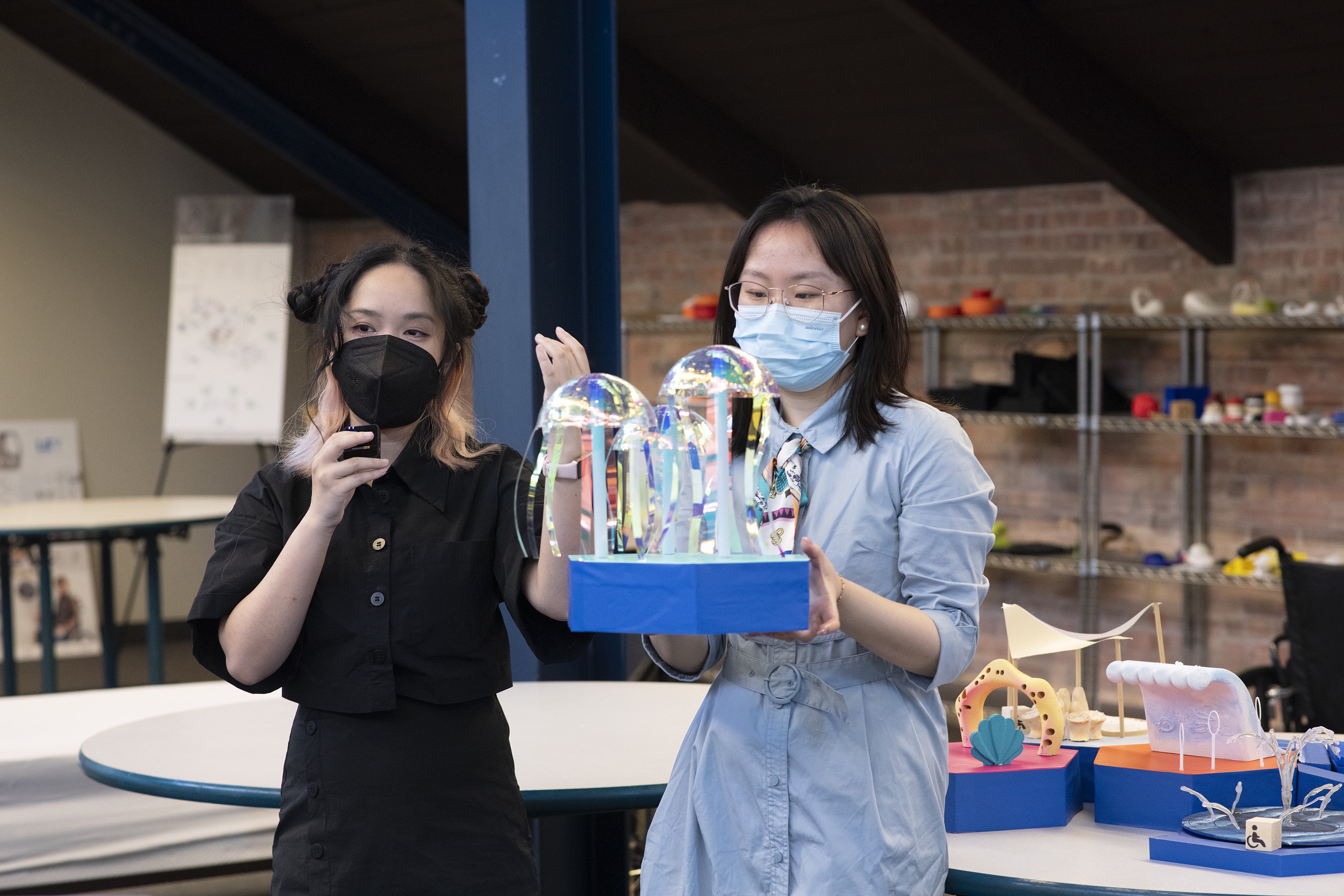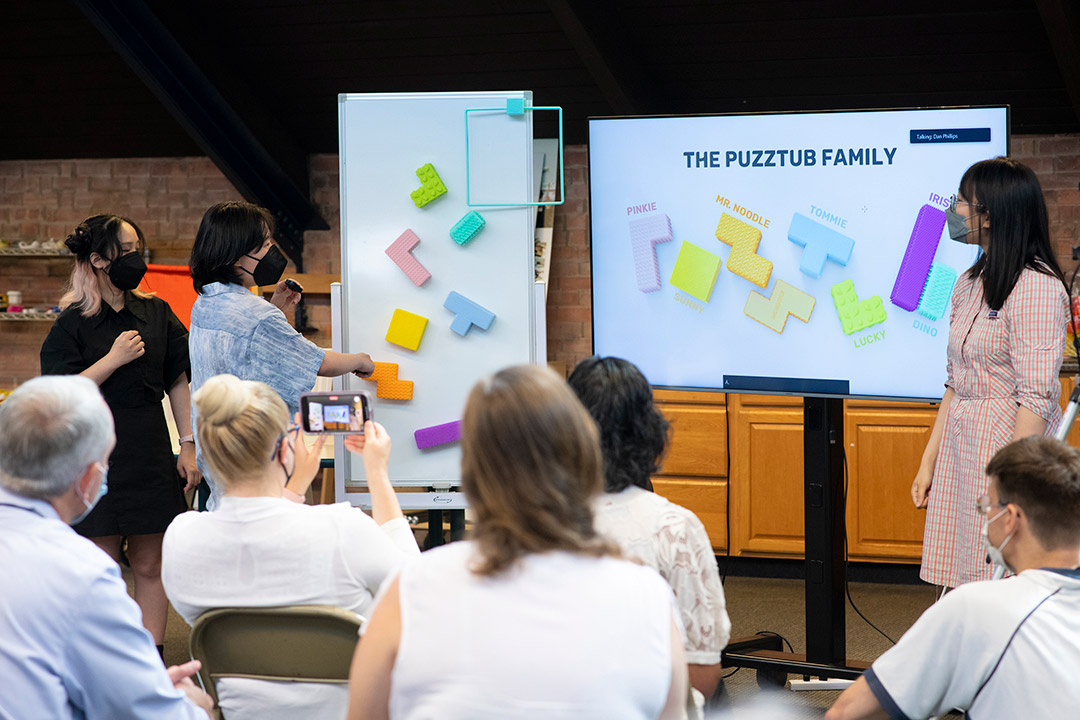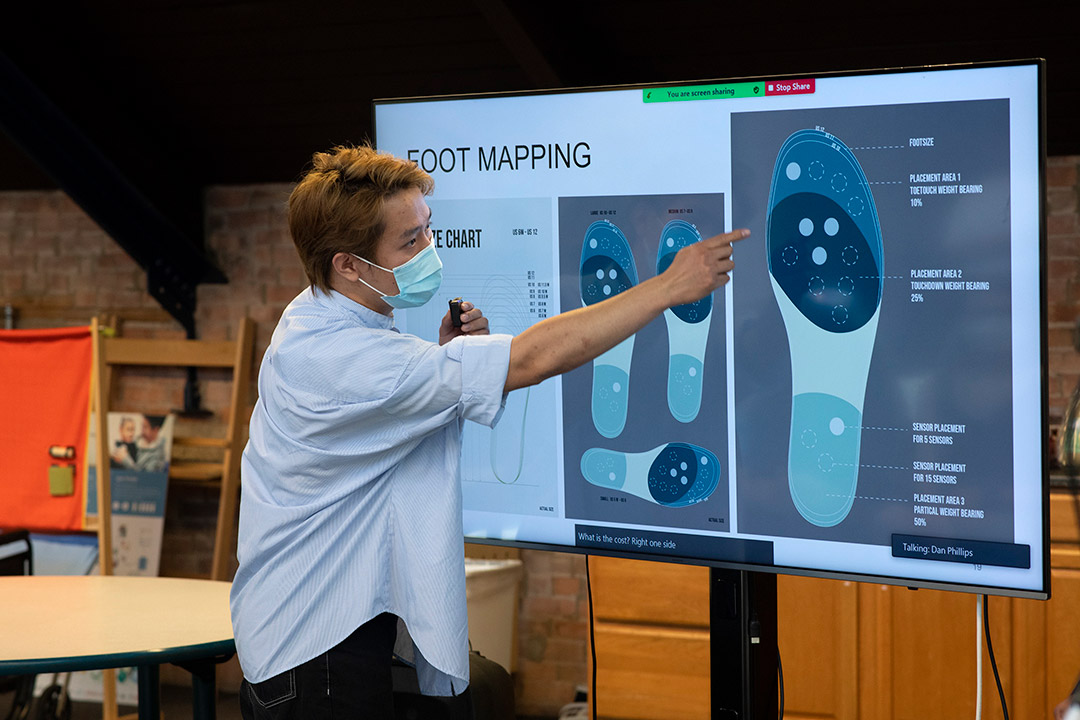RIT students use innovative design through Studio930 to enhance lives
A. Sue Weisler
RIT students Hannah Ni, left, and Rosie Ye helped developed the idea for an Inclusive Playground with an undersea theme for Studio930 design consultancy. The 10-week long summer experience is an interdisciplinary studio that focuses on the development of assistive healthcare solutions by leveraging the use of technology, art, and design
RIT student Hannah Ni has learned a lot about inclusive design through the course of her studies, but her most recent work developing a puzzle toy for children with autism and an inclusive playground for all ages and abilities has changed the way she now thinks about designing for end users.
Ni, a fourth-year industrial design and graphic design double major from Boston, is part of a cohort of students in this summer’s Studio930 design consultancy, an interdisciplinary studio that focuses on the development of assistive healthcare solutions by leveraging the use of technology, art, and design.
The 10-week long summer experience concluded with a student exhibition inside RIT’s LiveAbility Lab, a close partnership between RIT and the Al Sigl Community of Agencies, a collaborative network of organizations in Rochester that serve children and adults with special needs.
“This studio is an ideal way for our students to utilize their skills and design methods and work directly with clients as they would in a typical design consultancy,” said Dan Harel, the studio’s manager and adjunct professor of industrial design. Harel mentors students along with Stan Rickel, associate professor of industrial design in the School of Design and founding director of Studio930, and Dan Phillips, associate professor in the Kate Gleason College of Engineering, faculty associate for the Partnership for Effective Access Technology Research and Development, and LiveAbility Lab director. Studio930 is a program of the Simone Center for Innovation and Entrepreneurship directed by Richard DeMartino, the Albert J. Simone Endowed Chair for Innovation and Entrepreneurship and professor in Saunders College of Business.
A. Sue Weisler
PuzzTub is a puzzle toy for children with autism that aids in bath time.
Throughout the summer workshop, students are able to practice teamwork, conduct contextual interviews with real clients and review their project progress with them, receive feedback, and create working prototype solutions, Harel added. The students are also encouraged to continue developing their product solutions by enrolling in the Applied Entrepreneurship program at the Simone Center for Innovation and Entrepreneurship. They may also continue in the multi-disciplinary design program in the Kate Gleason College of Engineering or through an independent study.
Through research and interviews with parents and caregivers, Ni and her team revised their original design of an educational toy and transitioned to making an assistive toy that autistic children can use in the bathtub, which is traditionally a space that causes resistance.
“Generally, children with autism are more sensitive to texture than other children. In addition, many autistic children aren’t comfortable with physical contact and don’t enjoy bathing. We hope that our toy is not just a puzzle, but a tool that can help parents and their children,” said Ni.
She hopes that one day “Puzztub” can be sold in the marketplace based on their theoretical functioning and testing successes with waterproofing, floating, and absorption. This month, the team will submit the Puzztub concept to the Global Grad Show in Dubai in order to acquire additional funding for research and production.
Several other projects were developed during this summer’s Studio 930 Design Consultancy. They are:
Mobile Transfer Bar-- a safe, sturdy, and portable mobile bar for use when independently transferring from a wheelchair between two points in the home. Developed by Chase Kahn, industrial design; Steven Miller, mechanical engineering; and Brent Shaub, School of Individualized Study;
Therawalk – a device attached to a patient’s foot/feet after orthopedic surgery and during physical therapy to sense, display, and record pressure and force. Developed by Zoii Henry, biomedical engineering; Steven Miller, mechanical engineering; Sandra Lwin, biomedical engineering; and Jayden Zhou, industrial design;
Inclusive Playground –an interactive system for outdoor public places that encourages play and promotes inclusivity, and incorporates textures, engaging colors, and auditory and calming areas. Developed by Hannah Ni, industrial design; Chase Kahn, industrial design; Semy Kong, industrial design; and Rosie Ye, industrial design;
Craftable – an adaptable and adjustable art table promoting sensory development and social growth through drawing and painting. Developed by Angeline Hamele, sociology and anthropology; Sandra Lwin, biomedical engineering; Emma Scheinbart, industrial design; and Rosie Ye, industrial design;
Push-E – a handle bar that improves manual wheelchair maneuverability when pushing and pulling through all-terrain inclines. Developed by Angeline Hamele, sociology and anthropology; Chungmin Park, industrial design; and Nathanael Thomas, computer engineering;
Universal Bathroom – assists wheelchair users when transferring from chair to toilet with an ergonomically redesigned grab bar, and multifunctional, movable, and universally designed sink. Developed by Jayden Zhou, industrial design; Shen Liu, industrial design; and Yannan Pan, industrial design;
Safe Way – an external, adjustable, and stable handrail for use when climbing up and going down stairs. Developed by Brent Shaub, School of Individualized Study; Chungmin Park, industrial design, and Anqi Zhu, industrial design;
Baby Face – a solution that facilitates face-to-face contact between babies and caregivers using mirrors, cameras, Bluetooth connections, and tablets or phones. Developed by Emma Scheinbart, industrial design; Jacqueline Qiu, industrial design; and Shen Liu, industrial design;
Contamination Prevention – a series of solutions including a powder straw, UV/filter baby bottle, and milk box that improves delivery methods of instant formula for infants in developing nations in order to prevent cross contamination. Developed by Zoii Henry, biomedical engineering; Nathanael Thomas, computer engineering; and Semy Kong, industrial design; and
Heebo – a disinfection and storage system for use in developing countries that will make breastfeeding safer while disinfecting baby’s utensils after feeding. Developed by Yannan Pan, industrial design.
A. Sue Weisler
Jayden Zhou walks through his team's concept for Therawalk, a device that is attached to a patient's foot after orthopedic surgery and during physical therapy to sense, display, and record pressure and force.
“One of the most rewarding benefits of Studio 930 is seeing future industry professionals working from their hearts, caring for and engaging with individuals of all walks of life, and creating partnerships with incredible programs like Boards of Cooperative Educational Services (BOCES), the Al Sigl Center, and Mary Cariola Children's Center,” said Liza Savage-Katz, an adjunct professor in new media design at RIT, who served as faculty mentor for several projects including the Inclusive Playground. She is looking forward to the projects’ developments.
“I envision the inclusive playground becoming a showcase for Rochester and a wonderful addition to our community of play,” she said. “The addition of beautifully designed inclusive aquatic-themed play structures can be just the ticket to creating a healthier and happier environment for children and families. If this playground is a success in Rochester, it has the potential to be duplicated in other cities with shorelines, such as Santa Monica Beach in Los Angeles.”
Added Ni: “Through this incredible experience, I’ve learned that design isn’t always what it should be. Design needs to be responsive to the user's real needs. And that will give you inspiration for your design.”
In addition to Al Sigl, Studio930 has received the support of the industrial design MFA program, Kate Gleason College of Engineering, College of Engineering Technology, and Saunders College of Business.









